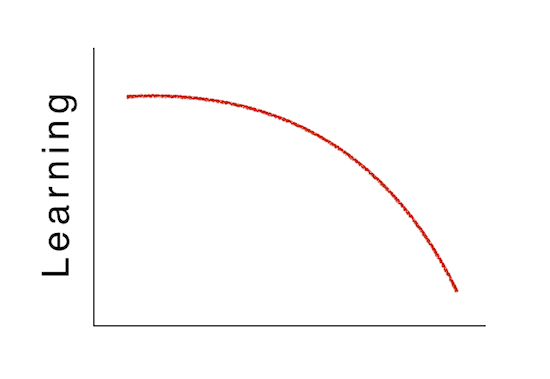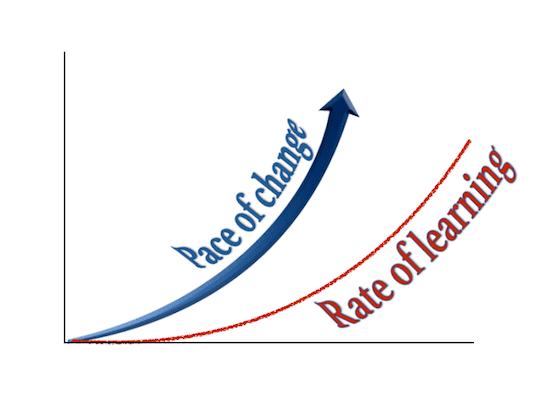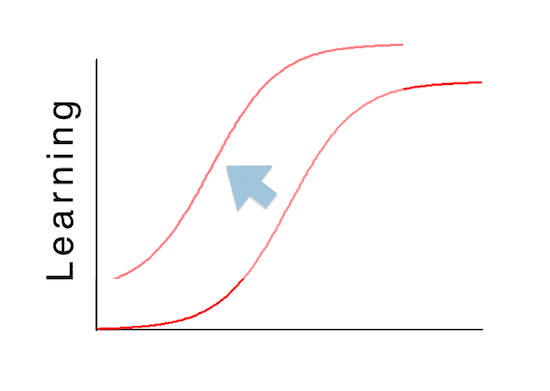Whether it is the effects of Moore’s Law or just the human urge to progress, the pace of change has accelerated and is leaving a lot of people in the dust. The major problem lies in the mindsets of the senior managers whose careers were built on other paradigms and whose bag of tricks has been somewhat invalidated. It is in this context that I believe that improving one’s personal learning curve has become a question of strategic importance, especially when we are talking about members of the Executive Committee. {Please tweet ♺} It’s about getting into the mindset of continuous learning.
Here is a resume of the problem for business:
The change has been happening, most patently, in technology with a very logical impact on the pace of innovation. However, the more subversive change has been happening in terms of people’s mindsets — be it the consumer, the employee or future recruits. For leaders, this is a double whammy.
The regressive learning curve
Too many executives are flying blind because they are not equipped to make appropriate decisions when it comes to matters of digital. Moreover, the very same people are suffering from an overloaded calendar, where they believe they don’t have the time for learning, much less to fidget with these new gadgets. Anchored in a mindset that has been set in a context of decades of success, top CEOs are prone to want just to carry on as they always have. In order to give way for the new mindset, leaders need to unlearn some of their ingrained habits. {♺} They may even need to revisit their guiding principles. As an obvious example, fear & control leadership — that remains so prevalent in big business — does not encourage the right environment for learning, for taking risks and for sharing mistakes. In such situations, the learning curve risks looking more like this:

Fig 2: Irony: What happens when you don’t unlearn
Learning as source of energy
If there is one saving grace to this manic-paced life that we’re experiencing, it is that we are getting to learn something new every day.{♺} If staying on top of the new digital devices, tools and platforms is a necessary part of my own regime, it must also become a habit for all leaders — no matter the position or sector. The big change for leaders is that digital is something you need to experience yourself to truly understand.{♺} Reading about it in newspapers, magazines and blog posts is just not enough.
In a phrase to which I subscribe entirely in dealing with this digital revolution, C.S. Lewis wrote (in a foreword):
“It has always [therefore] been one of my main endeavours as a teacher to persuade the young that first-hand knowledge is not only more worth acquiring than second-hand knowledge, but it is usually much easier and more delightful to acquire.”
Trial, test and experiment
Similarly, as it goes for these new digital tools and platforms, you need to experience them first-hand in order to understand them. There is nothing more instructive than finding an annoying ad popping up in your Facebook feed, to understand the intrusive nature of bad ads. As I mentioned at the outset of this post, it is now strategic to enhance one’s personal learning curve.
Not only is the state of continuous learning a perfect way to stay young and invigorated, it is the only way to survive.{♺} In the case of digital, the learning must be first hand. If staying young is the ultimate why, the challenge turns to implementation. So, the question for leaders:
What are you going to do differently in order to find the time to trial, test and experiment?
Your thoughts and reactions?













Leaders have to continuously learn to be able to cope with the pace of change. It is a matter of aligning themselves with the turning point, and that is between the old world and the new world. Leaders have to change their paradigm in order for business to survive and prosper – Obeng , (1997).
Well put Cathrine! A lot of unlearning to do as well.